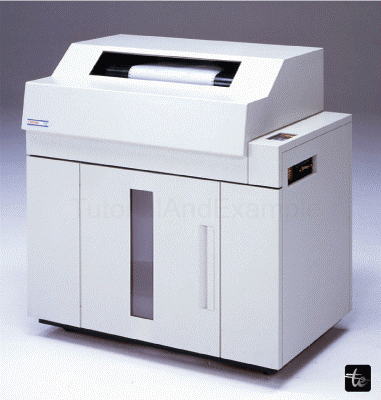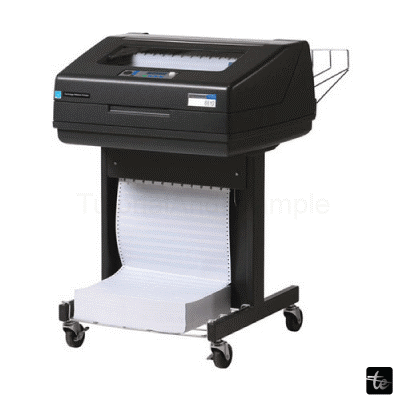Line Printers and their Applications
Line Printers and their Applications
Introduction
In an era of rapid technical growth, it is crucial to acknowledge the trailblazing discoveries that served as the building blocks for contemporary printing techniques. One of these revolutionary technologies that had a significant impact on people's lives and businesses around the globe was the line printer. This article explores the background, operation, and significance of line printers, emphasizing how they helped to create the modern printing industry.
What are Line Printers?
Computer printers known as line printers were frequently utilized in the past for printing activities requiring speed and volume. They were frequently employed in commercial settings, data centers, and enormous computer systems where massive volumes of data had to be continuously printed. Line printers were common throughout the mainframe and early minicomputer eras, but more recent printing technologies like laser and inkjet printers have mostly superseded them.
Types of line Printers
In the past, line printers were a common technology for high-speed, high-volume printing, especially in office and data center settings. Based on their printing mechanisms, line printers might be divided into two primary categories:
1. Drum Printers
A rotating drum serves as the print head in drum printers. The drum is normally cylindrical and includes engravings of characters or patterns on it. The paper is pressed up against the turning drum, which spins while the necessary characters move past the paper. A sequence of print hammers or pins smashes the paper against an inked ribbon to transfer the character onto the paper when a character needs to be printed. Drum printers could print quickly and were frequently found in mainframe computer systems.
Daily Life Applications of Drum Printers
- Business Environment: Drum printers were frequently employed in commercial settings in the past, particularly in big organizations and data centers. They worked on projects that required high-speed, continuous printing, like printing reports, invoices, shipping labels, and other bulk papers.
- Manufacturing and Industrial Settings: Drum printers were used to print labels, barcodes, and other production-related documents in some manufacturing and industrial settings.
- Banking and Financial Services: Banks and other financial institutions printed statements, transaction logs, and other financial documents using drum printers. They were able to manage massive data volumes, making them efficient at processing financial data.
- Printing Utilities and Logs: Drum printers have been used in several computing settings to print debugging information, utility output, and system logs. These printers could produce copious logs quickly, aiding system administrators in troubleshooting problems and keeping track of system performance.
- Government and Administrations: Government offices and administrative departments used drum printers to print a variety of important papers, forms, and records that needed to be printed quickly and accurately.
Drum printers, despite their historical significance, have largely been phased out due to their shortcomings. They can be less cost-effective than other printing technologies due to their noise, low print quality in comparison to modern printers, and need for constant ribbon ink supply.

2. Chain Printers
Instead of a rotating drum, chains with character patterns are used in chain printers. The chain is a perpetual loop that rotates in a circle. Each link in the chain represents a letter or symbol. The right characters line up with the print position as the chain turns, and print hammers or pins then strike the paper against the inked ribbon to produce the characters on the page. Chain printers were utilized in applications where drum printers were employed and were also capable of high-speed printing.
Daily Life Applications of Chain Printers
- Business and Data Processing: In offices and data centers, chain printers were frequently utilized for high-volume printing activities. They were frequently used to print payroll records, invoices, reports, and other business papers that needed to produce quickly and continuously.
- Real-Time Systems: When continuous and quick printing of data was necessary for real-time systems and monitoring applications, chain printers were occasionally used.
- Airline and Travel Industry: Chain printers were used to print tickets, itineraries, and boarding permits in airline reservation systems and travel firms.
- Inventory and Manufacture: Product labels, barcodes, and other production-related documents were printed using chain printers in several manufacturing and inventory management systems.
- Banking and Financial Services: Statements, account information, checks, and other financial documents were printed in banks and other financial institutions using chain printers.
Advantages of Line Printers
Line printers had various features that made them appropriate for particular applications during their heyday while being mostly supplanted by more contemporary printing technologies.
The following are a few benefits of line printers:
- High-Speed Printing: Line printers were renowned for their incredibly quick printing. They were perfect for high-volume printing operations that required quick output because they could print hundreds to thousands of lines per minute.
- Continuous Form Printing: Long texts could be printed online printers without the requirement for periodic paper reloading because they could handle continuous forms or big rolls of paper. Printing reports, logs, and other lengthy documents were made especially easy by this function.
- Carbon Copies: Line printers were excellent for duplicating printed documents without the need for extra equipment because they could make many carbon copies at once.
- Continuous Fanfold Papers: Another factor that increased the dependability of line printers was the use of continuous fanfold paper, which was less prone to paper jams than individual sheets of paper.
- Reliability: Line printers were thought to be dependable and able to handle huge workloads without experiencing frequent failures because of their mechanical design.
- Simple Operation: Line printers featured a simple operating system that made them simple to use and keep up. Consumables became simpler and more widely available because they didn't require complicated toners or cartridges.
- Durability: Line printers are appropriate for demanding situations like data centers and industrial settings because they were designed to be strong and long-lasting.
- Cost-Effective: For large-scale printing requirements, line printers were comparatively affordable when compared to various other printing technologies of the time. Line printers often have cheaper page costs than alternatives like laser printers.
Line printers have some significant downsides despite these benefits. They were less adaptable than contemporary printers like laser and inkjet printers due to their noise, poor print quality, and primary suitability for monochrome text printing. The drawbacks of line printers contributed to their demise as printing technology developed, and they have since been mostly superseded by more effective and adaptable printing options for daily use.
Disadvantages of Line Printers
Line printers did have several problems and restrictions despite being widely used. They frequently required frequent maintenance and were noisy and large. Furthermore, it could be difficult to switch fonts or character sets on some models. Some of the disadvantages are:
- Noise: Line printers' impact printing technique made them very noisy while they were in use. Print hammers and pins made loud, continuous noise when repeatedly struck against paper and inked ribbons, which was annoying in otherwise calm offices.
- Maintenance and Repair: Line printers required routine maintenance and were more vulnerable to mechanical failures due to their mechanical nature, which increased downtime and repair costs.
- Limited Printing Capabilities: Modern printing applications that call for high-quality graphics, pictures, or printing on diverse media types like labels, transparencies, or envelopes were incompatible with line printers.
- Large Footprints: Line printers were frequently big, unwieldy devices that took up a lot of room in offices.
- Paper Jams: Line printers might still encounter paper jams while employing continuous fanfold paper, which was less likely to jam and required manual intervention to remove.
- Limited Font Flexibility: Line printers had fixed character sets, making it impossible to use them for activities that required a variety of font styles without physically altering the drum or chain.
- Consumable Costs: Inked ribbons were utilized by line printers, and as they had to be constantly replaced due to wear and tear, the ongoing running costs increased.
- Monochrome Printing Only: Line printers were incapable of printing in color and were primarily used for printing monochrome text. Due to this restriction, they were inadequate for activities requiring accurate color representation or high-quality graphics.
- Limited Printed Quality: In comparison to more recent printers like laser and inkjet printers, the print quality of line printers was comparatively poor. The impact mechanism frequently resulted in less sharp and clear characters, which led to less visually acceptable output, especially for drawings or photographs.
Overall, line printers were formerly useful for certain high-volume printing demands, but with the development of printing technology, they are now less useful for the majority of contemporary printing needs. Modern printers are more suited for routine printing chores in both personal and business settings because of their greater print quality, color capabilities, quiet operation, and extensive range of functions.

Legacy and Impact on Printing Technology
Line printers are now seen as a thing of the past, although their legacy still has an impact on printing technology. The idea of printing full lines at once paved the way for the fast laser and inkjet printers that currently rule the industry. Additionally, the advancement of other industries like robotics and automation benefited from the insights learned during the development of line printers.
Conclusion
Line printers were a game-changing invention that significantly influenced the printing industry. They developed the idea of printing complete lines at once, greatly enhancing printing productivity. Although line printers are no longer widely used, their influence can be seen in the printing technologies that came after. It is crucial to keep in mind and celebrate the historic shift that line printers brought about in the printing industry as we wonder at the level of printing technology today.